Fragmentation Characteristics of Bubbles in a Throttling Hole Pipe
Abstract
1. Introduction
2. Experiment
2.1. Experiment Preparation
2.2. Experiment Setup
2.3. Image Recognition and Processing
3. Materials and Methods
3.1. Model Structure and Fragmentation Principle
3.2. Governing Equation
3.3. Numerical Simulation Methods
3.3.1. Geometric Model and Grid Partitioning
3.3.2. Selection of Numerical Simulation Model and Boundary Condition Settings
3.3.3. Mesh Independence Verification
3.3.4. Physical Model Testing and Verification
3.3.5. Simulation Model
4. Analysis of Numerical Calculation Results
4.1. The Fragmentation Process of Bubbles in the Throttling Orifice Tube
4.2. The Influence of Inlet Velocity on the Characteristics of Bubble Fragmentation
4.3. Effect of Throttling Orifice Diameter
4.4. Effect of Expansion Length on Bubble Fragmentation Characteristics
5. Experimental Results Analysis
5.1. Effect of Inlet Velocity on Bubble Fragmentation Characteristics
5.2. Effect of Orifice Diameter on Bubble Fragmentation Characteristics
5.3. Effect of Expansion Segment Length on Bubble Fragmentation Characteristics
6. Conclusions
- (1)
- The internal bubble fragmentation in the throttle orifice tube can be divided into three stages: deformation, stretching, and fragmentation. Changes in fluid velocity, pressure, turbulent dissipation rate, and turbulent kinetic energy mainly occur in the contraction and expansion segments. The difference between wall velocity and central velocity is the main reason for the uneven bubble size and different bubble distribution.
- (2)
- As the throttle ratio decreases, the fragmentation performance of bubbles improves, but there is a limit to the decrease in the throttle ratio. In this study, a throttle ratio of 4/18 (orifice diameter of 4 mm) was chosen as the optimal throttle ratio.
- (3)
- The variation in expansion segment length of the throttle orifice tube has a relatively small effect on bubble fragmentation performance. In this study, an expansion segment length of 30 mm was selected for the throttle orifice tube.
- (4)
- With an increase in the inlet velocity of the throttle orifice tube, the fragmentation performance of bubbles also improves. In this study, an inlet velocity of 2 m/s was chosen for the throttle orifice tube.
Author Contributions
Funding
Institutional Review Board Statement
Informed Consent Statement
Data Availability Statement
Conflicts of Interest
References
- Yin, J.L.; Li, J.J.; Li, H.; Liu, W.; Wang, D. Experimental study on the bubble generation characteristics for an Venturi type bubble generator. Int. J. Heat Mass Transf. 2015, 91, 218–224. [Google Scholar] [CrossRef]
- Wu, M.; Song, H.; Liang, X.; Huang, N.; Li, X. Generation of micro-nano bubbles by self-developed swirl-type micro-nano bubble generator. Chem. Eng. Process. Process Intensif. 2022, 181, 109136. [Google Scholar] [CrossRef]
- Yasuda, K.; Matsushima, H.; Asakura, Y. Generation and reduction of bulk nanobubbles by ultrasonic irradiation. Chem. Eng. Sci. 2019, 195, 455–461. [Google Scholar] [CrossRef]
- Levitsky, I.; Tavor, D.; Erenburg, V. A new bubble generator for creation of large quantity of bubbles with controlled diameters. Exp. Comput. Multiph. 2022, 4, 45–51. [Google Scholar] [CrossRef]
- Liao, Y.; Ma, T. Study on bubble-induced turbulence in pipes and containers with Reynolds-stress models. Exp. Comput. Multiph. Flow 2022, 4, 121–132. [Google Scholar] [CrossRef]
- Mahmoudi, S.; Saeedipour, M.; Hlawitschka, M.W. Bubble dynamics under the influence of the Marangoni force induced by a stratified field of contamination. Exp. Comput. Multiph. Flow 2024, 1–12. [Google Scholar] [CrossRef]
- Wang, B.; Lu, X.; Tao, S.; Ren, Y.; Gao, W.; Liu, X.; Yang, B. Preparation and properties of CO2 micro-nanobubble water based on response surface methodology. Appl. Sci. 2021, 11, 11638. [Google Scholar] [CrossRef]
- Temesgen, T.; Bui, T.T.; Han, M.; Kim, T.I.; Park, H. Micro and nanobubble technologies as a new horizon for water-treatment techniques: A review. Adv. Colloid Interface Sci. 2017, 246, 40–51. [Google Scholar] [CrossRef] [PubMed]
- Agarwal, A.; Ng, W.J.; Liu, Y. Principle and applications of microbubble and nanobubble technology for water treatment. Chemosphere 2011, 84, 1175–1180. [Google Scholar] [CrossRef]
- Zhao, X.J.; Zong, Z.; Jiang, Y.C. Numerical analysis of plate microbubble drag reduction based on OpenFOAM. Ship Mech. 2020, 24, 989–996. [Google Scholar] [CrossRef]
- Yao, K.; Chi, Y.; Wang, F.; Yan, J.; Ni, M.; Cen, K. The effect of microbubbles on gasliquid mass transfer coefficient and degradation rate of COD in waste water treatment. Water Sci. Technol. 2016, 73, 1969–1977. [Google Scholar] [CrossRef] [PubMed]
- Parmar, R.; Majumder, S.K. Mineral beneficiation by ionic microbubble in continuous plant prototype: Efficiency and its analysis by kinetic model. Chem. Eng. Sci. 2016, 142, 42–54. [Google Scholar] [CrossRef]
- Wang, T.F.; Wang, J.F.; Jin, Y. A novel theoretical breakup kernel function forbubbles/droplets in a turbulent flow. Chem. Eng. Sci. 2003, 58, 629–4637. [Google Scholar] [CrossRef]
- Kolmogorov, A.N. On the breakage of drops in a turbulent flow. Dokl. Akad. Navk. SSSR 1949, 66, 825–828. [Google Scholar]
- Hinze, J.O. Fundamentals of the hydrodynamic mechanism of splitting in dispersion processes. Aiche J. 2010, 1, 289–295. [Google Scholar] [CrossRef]
- Fujiwara, A.; Okamoto, K.; Hashiguchi, K.; Peixinho, J.; Takagi, S.; Matsumoto, Y. Bubble Breakup Phenomena in a Venturi Tube. In Proceedings of the Fluids Engineering Division Summer Meeting, San Diego, CA, USA, 30 July–2 August 2007; Volume 42886, pp. 553–560. [Google Scholar]
- Ma, Z.W.; Li, H.; Liu, W.; Liu, G.M.; Zhang, Q.; Yang, G.; Wei, F. Research on the movement and fragmentation of bubbles in the throat and expansion section of Venturi bubble generator. Nucl. Technol. 2018, 41, 110602. [Google Scholar] [CrossRef]
- Lau, Y.M.; Bai, W.; Deen, N.G.; Kuipers, J.A.M. Numerical study of bubble breakup in bubbly flows using a deterministic Euler–Lagrange framework. Chem. Eng. Sci. 2014, 108, 9–22. [Google Scholar] [CrossRef]
- Kawashima, H.; Fujiwara, A.; Saitoh, Y.; Hishida, K.; Kodama, Y. Experimental study of frictional drag reduction by microbubbles: Laser measurement and bubble generator. In Proceedings of the Fifth Symposium on Smart Control of Turbulence, Tokyo, Japan, 29 February–2 March 2004. [Google Scholar]
- Zhao, L.; Mo, Z.; Sun, L.; Xie, G.; Liu, H.; Du, M.; Tang, J. A visualized study of the motion of individual bubbles in a venturi-type bubble generator. Prog. Nucl. Energy 2017, 97, 74–89. [Google Scholar] [CrossRef]
- Zhao, L.; Sun, L.; Mo, Z.; Tang, J.; Hu, L.; Bao, J. An investigation on bubble motion in liquid flowing through a rectangular Venturi channel. Exp. Therm. Fluid Sci. 2018, 97, 48–58. [Google Scholar] [CrossRef]
- Ding, G.D.; Chen, J.Q.; Cai, X.L.; Yei, F.; Li, Z.L.; Ji, Y.Y.; Guo, J. Numerical simulation of single bubble breaking behavior in Venturi microbubble generator. Chem. Ind. Eng. Prog. 2020, 39, 2590–2598. [Google Scholar] [CrossRef]
- Ding, G.D.; Chen, J.Q.; Wang, C.S.; Shang, C.; Liu, M.L.; Cai, X.L.; Ji, Y.Y. Research onto the structural design and numerical simulation of axial-swirling type microbubble generator. Chin. J. Process Eng. 2018, 18, 934–941. [Google Scholar] [CrossRef]
- Ding, G.D.; Chen, J.Q.; Li, Z.L.; Cai, X.L. Analysis of the influence of injection hole position on the bubble-forming characteristics of Venturi tube microbubble generator. J. Chem. Eng. 2021, 72, 5552–5562. [Google Scholar] [CrossRef]
- Tang, W.C.; Yan, C.Q.; Sun, L.C.; Liu, W.; Li, H. Characteristic of bubble breakup in Venturi-type bubble generator. At. Energy Sci. Technol. 2014, 48, 844–848. [Google Scholar] [CrossRef]
- Ali, M.; Yan, C.; Sun, Z.; Wang, J.; Gu, H. CFD simulation of dust particle removal efficiency of a venturi scrubber in CFX. Nucl. Eng. Des. 2013, 256, 169–177. [Google Scholar] [CrossRef]
- Nomura, Y.; Uesawa, S.I.; Kaneko, A.; Abe, Y. Study on bubble breakup mechanism in a Venturi tube. In Proceedings of the Fluids Engineering Division Summer Meeting, Hamamatsu, Japan, 24–29 July 2011; Volume 44403, pp. 2533–2540. [Google Scholar]
- Shao, Z.Y.; Zhang, H.Y.; Sun, L.C.; Mou, Z.Y.; Du, M. Bubble breakup mechanismin Venturi-type bubble generator. CIESC J. 2018, 69, 110–116. [Google Scholar]
- Li, W.P. Computational Fluid Mechanics; Huazhong University of Science and Technology Press: Wuhan, China, 2004. [Google Scholar]
- Chen, P.; Sanyal, J.; Dudukovi, M.P. Numerical simulation of bubble columns flows: Effect of different breakup and coalescence closures. Chem. Eng. Sci. 2005, 60, 1085–1101. [Google Scholar] [CrossRef]
- Chen, W.Y.; Tang, K.; Sun, B.; Chen, X.D. Research on improved nozzle of bubble generator and two phase flow based on numerical simulation. Coal Prep. Technol. 2012, 26, 19–22. [Google Scholar]
- Li, Z.; Shi, W.; He, W.; Fan, Y.; Luo, H. Computer simulation method for the bubbling performance of the vortex microbubble generator. In Proceedings of the 2015 International Conference on Electromechanical Control Technology and Transportation, Zhuhai, China, 31 October–1 November 2015; Atlantis Press: Amsterdam, The Netherlands, 2015; pp. 250–253. [Google Scholar]
- Wang, L.; Jia, Y.; Yan, X.; Zhou, C. Gas liquid numerical simulation on microbubble generator and optimization on the nozzle to throat spacing. Asia-Pac. J. Chem. Eng. 2015, 10, 893–903. [Google Scholar] [CrossRef]
- Basso, A.; Hamad, F.A.; Ganesan, P. Effects of the geometrical configuration of air-water mixer on the size and distribution of microbubbles in aeration systems. Asia-Pac. J. Chem. Eng. 2018, 13, e2259. [Google Scholar] [CrossRef]
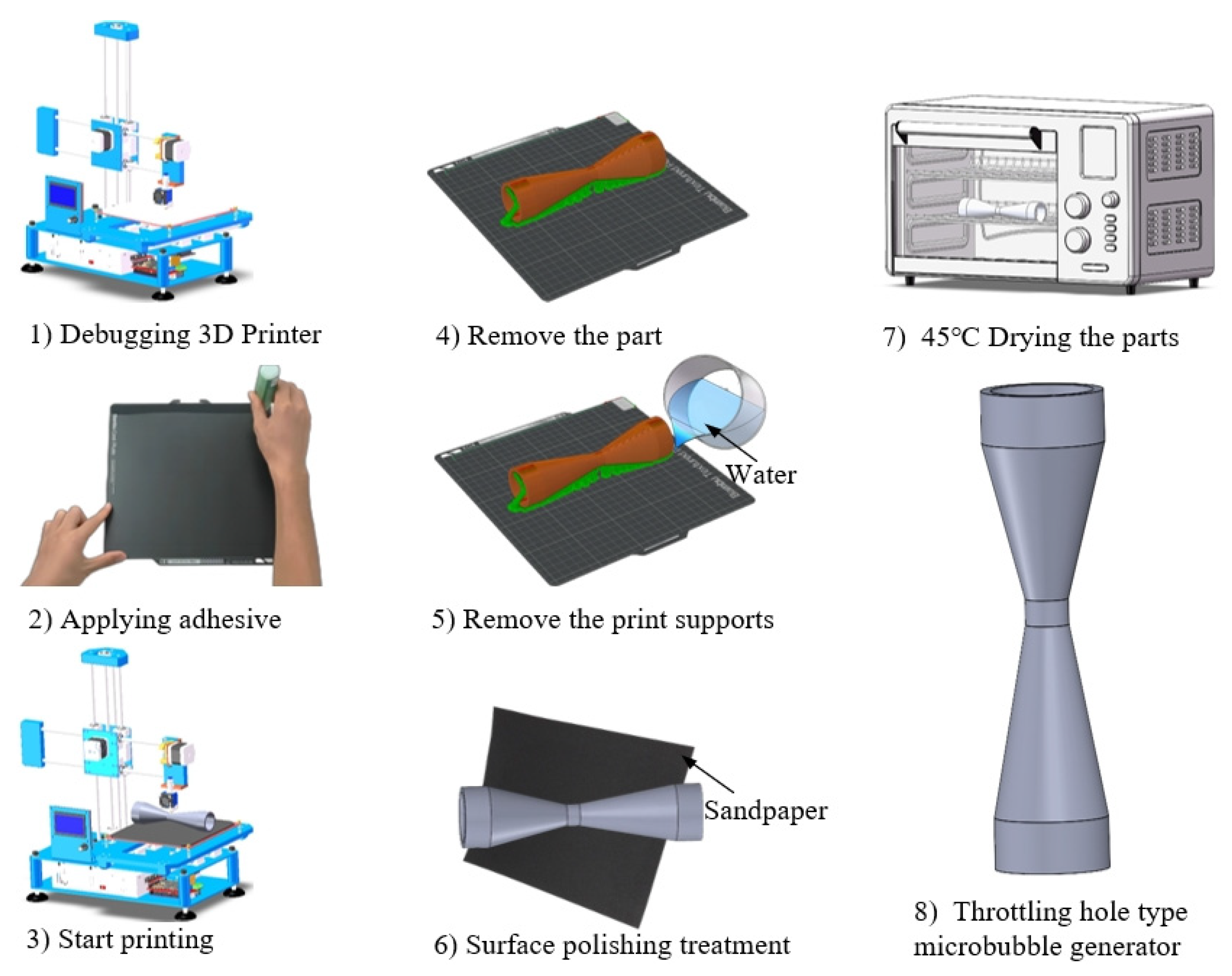

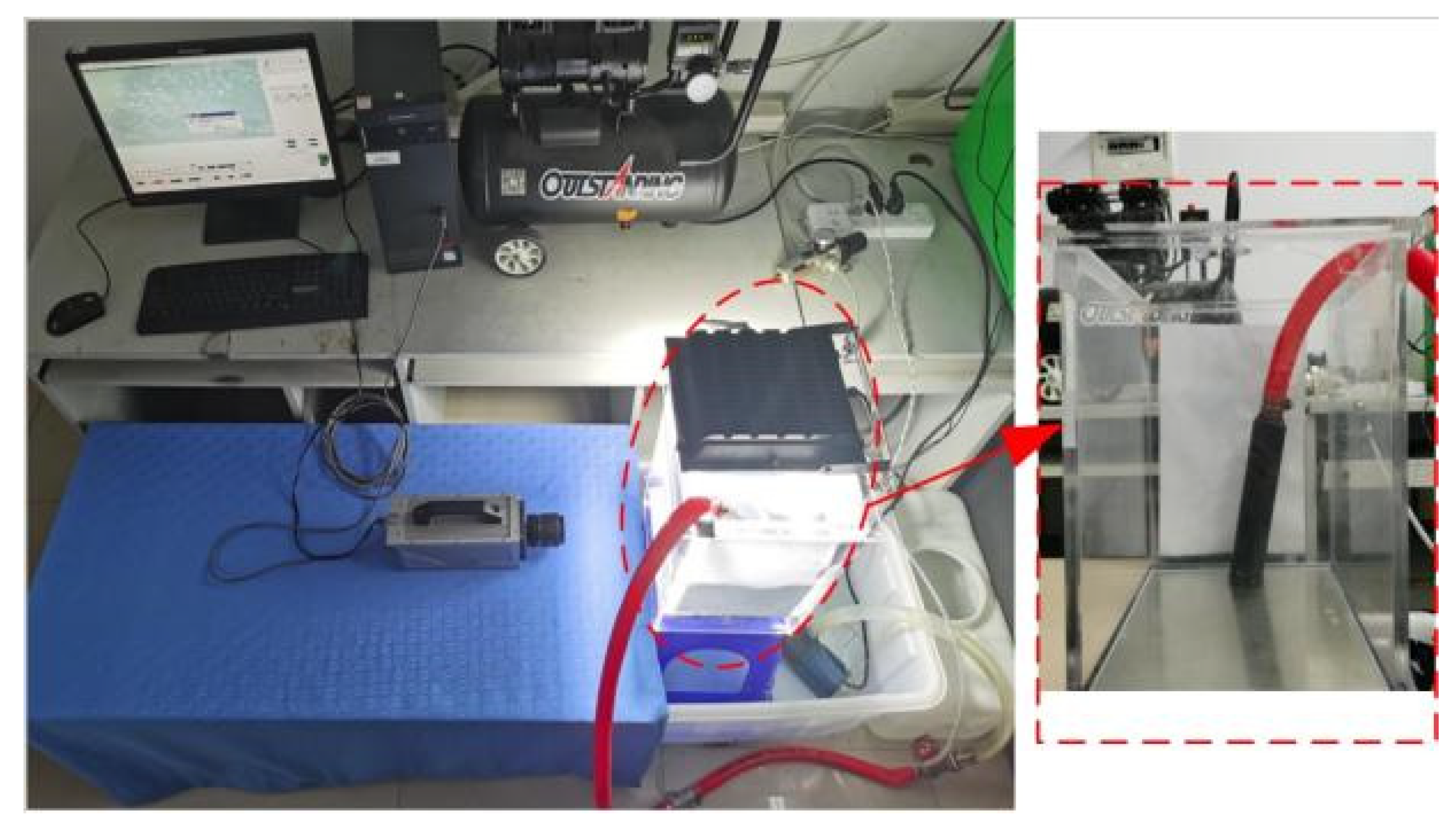
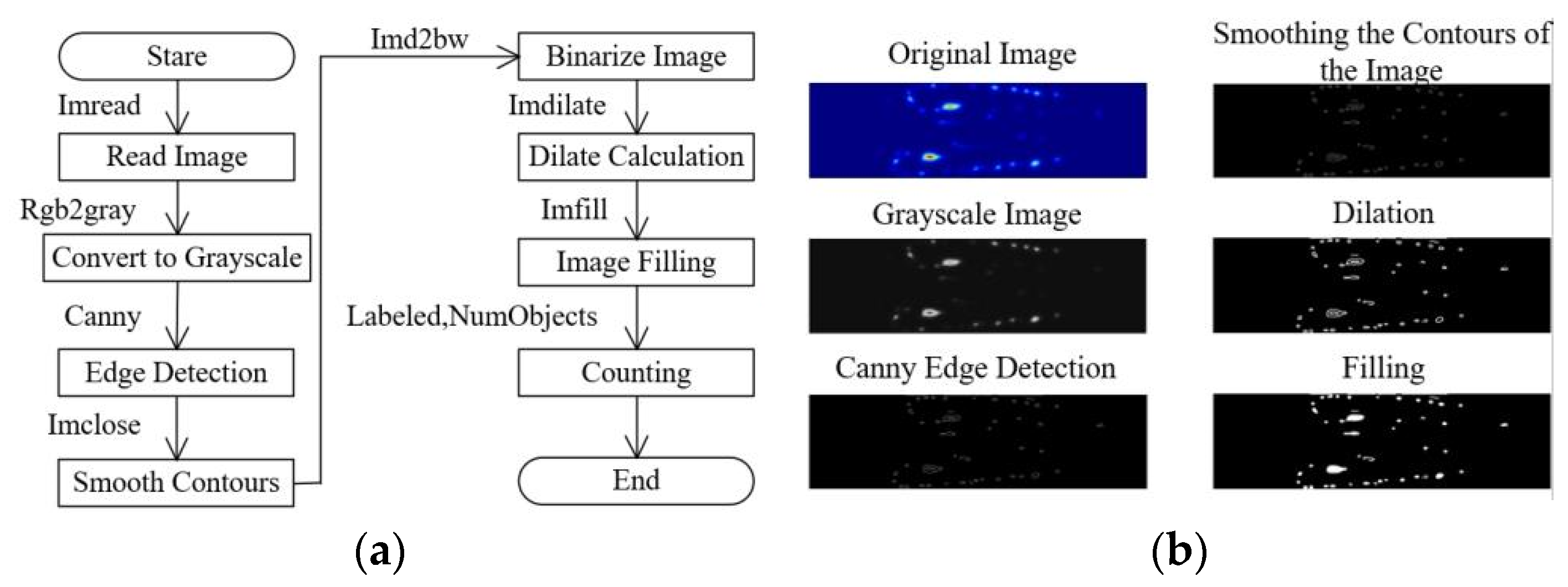


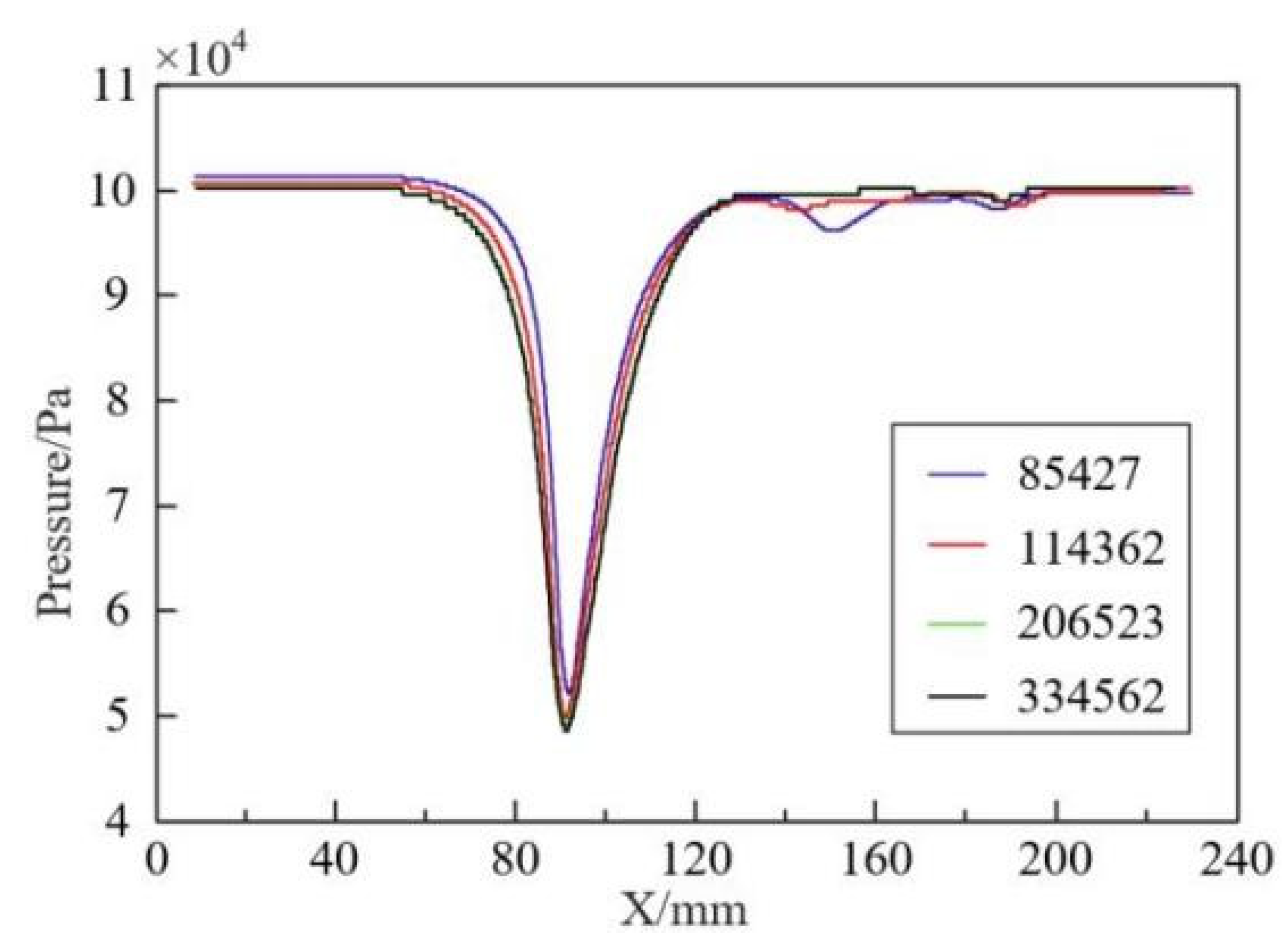
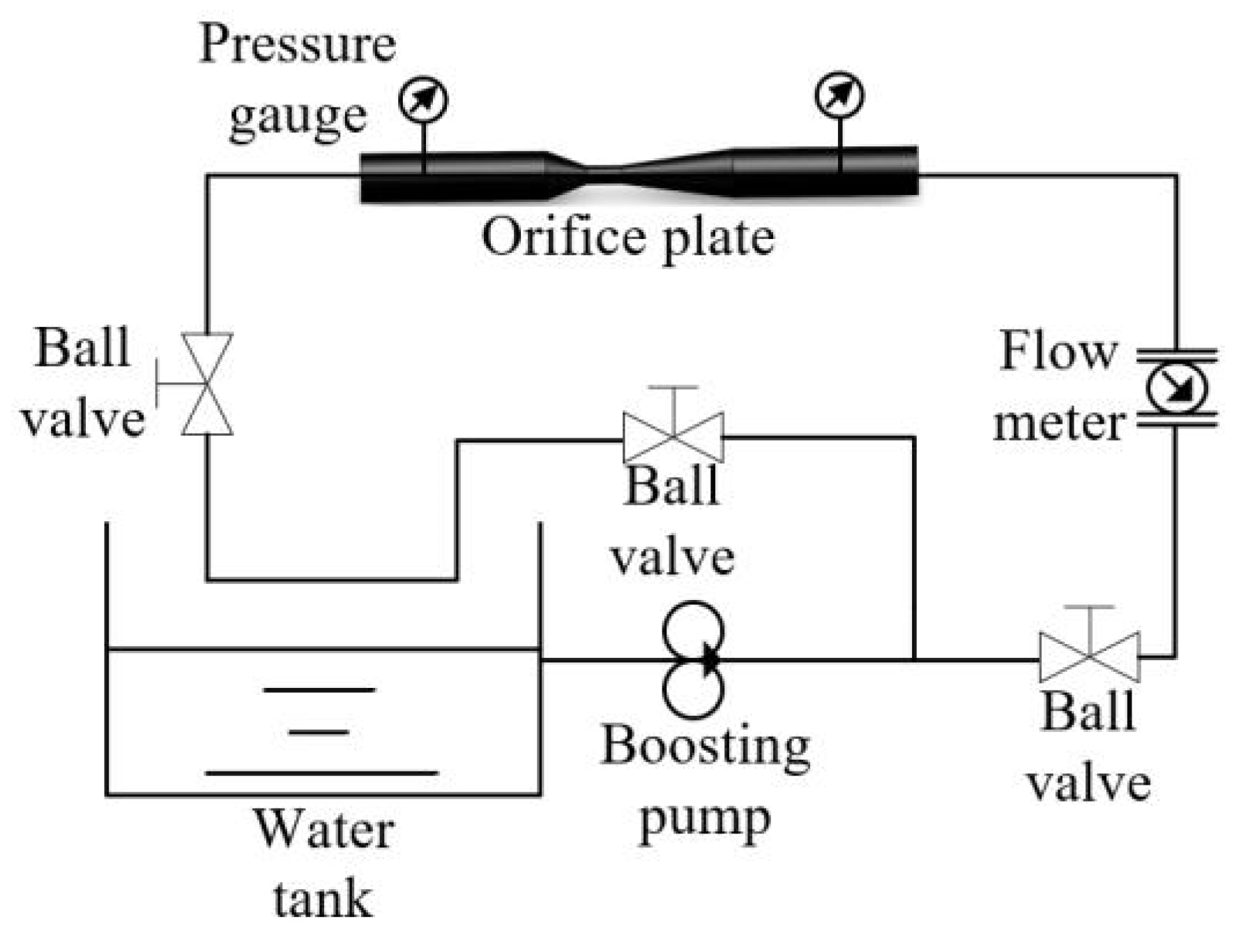

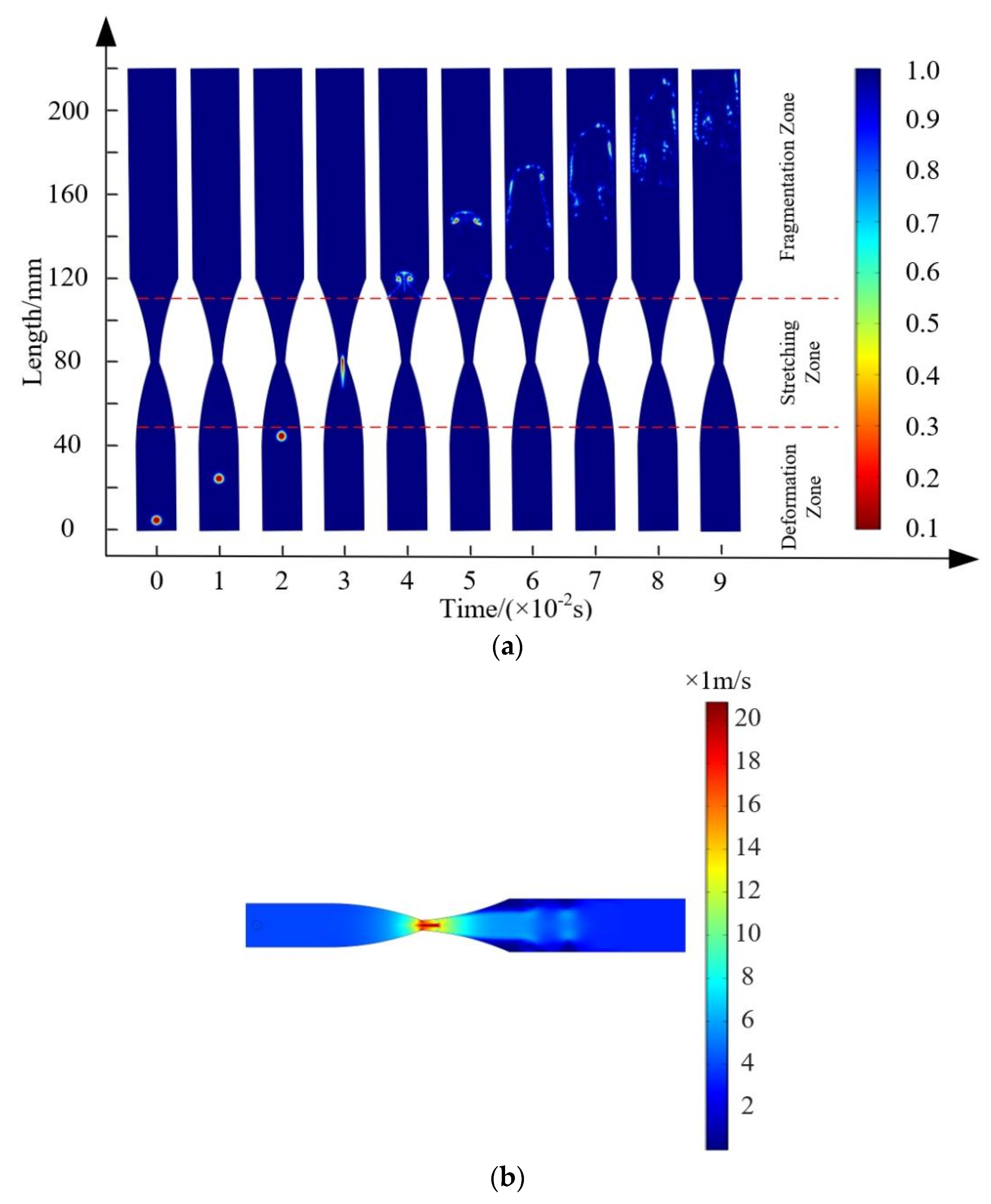
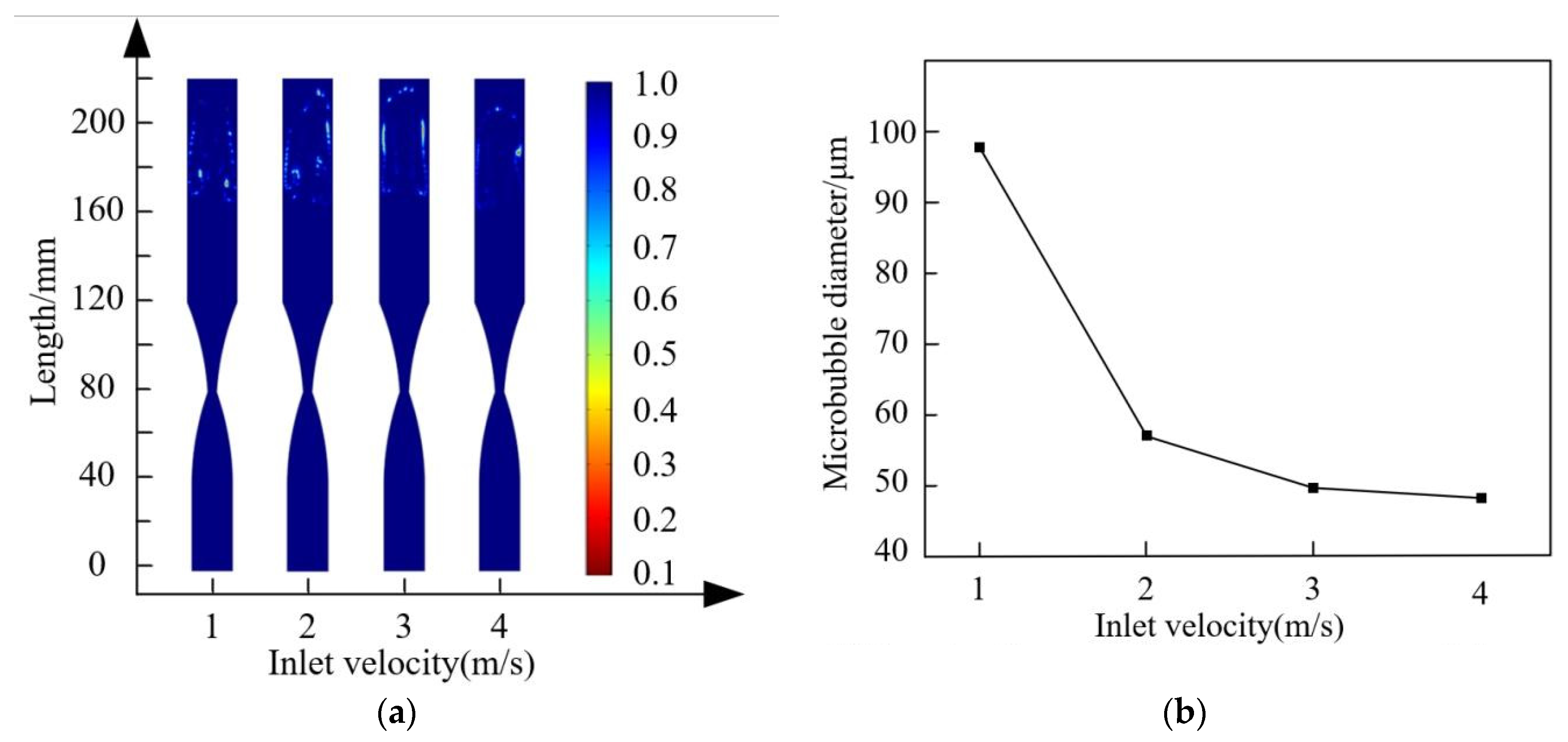
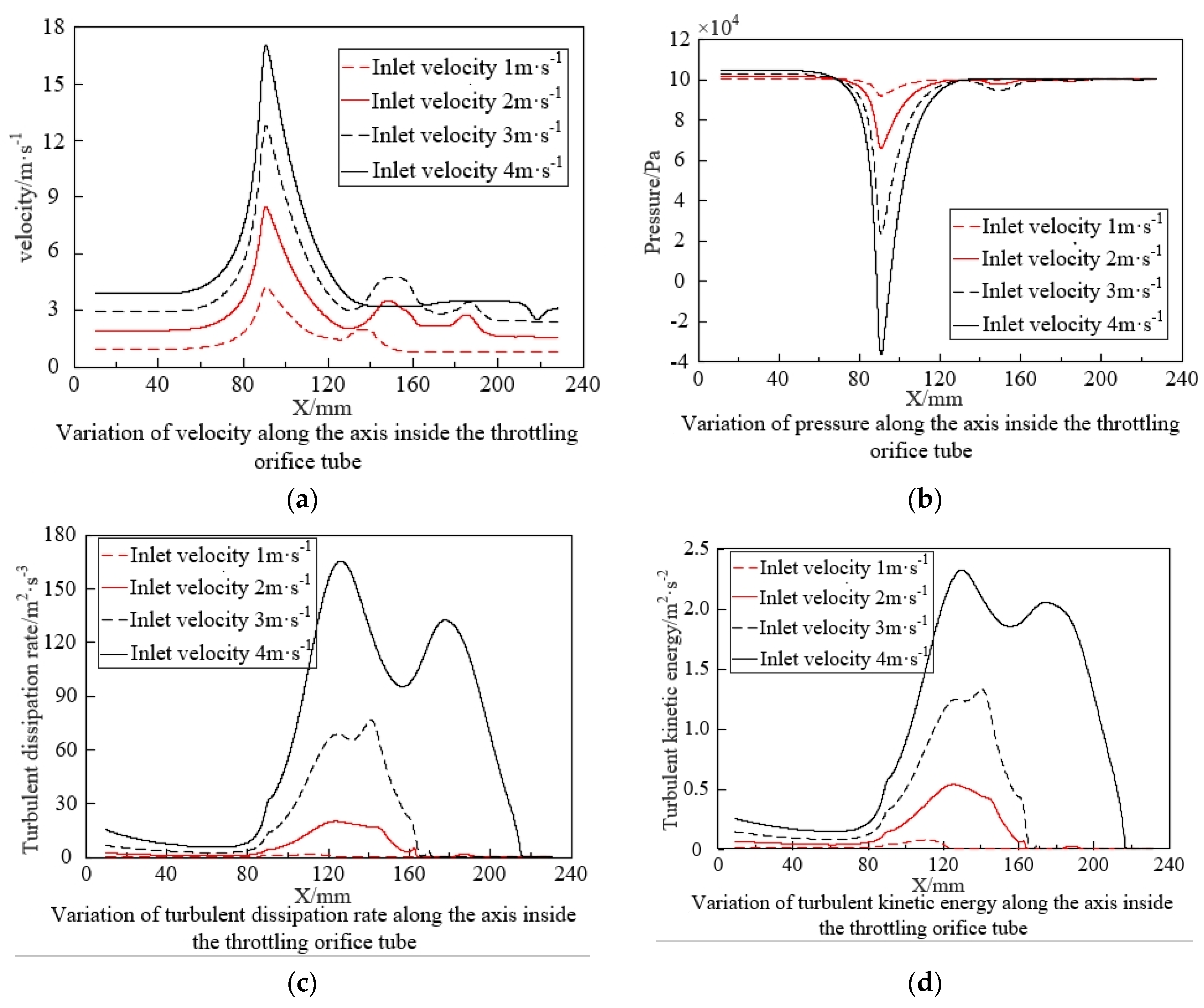
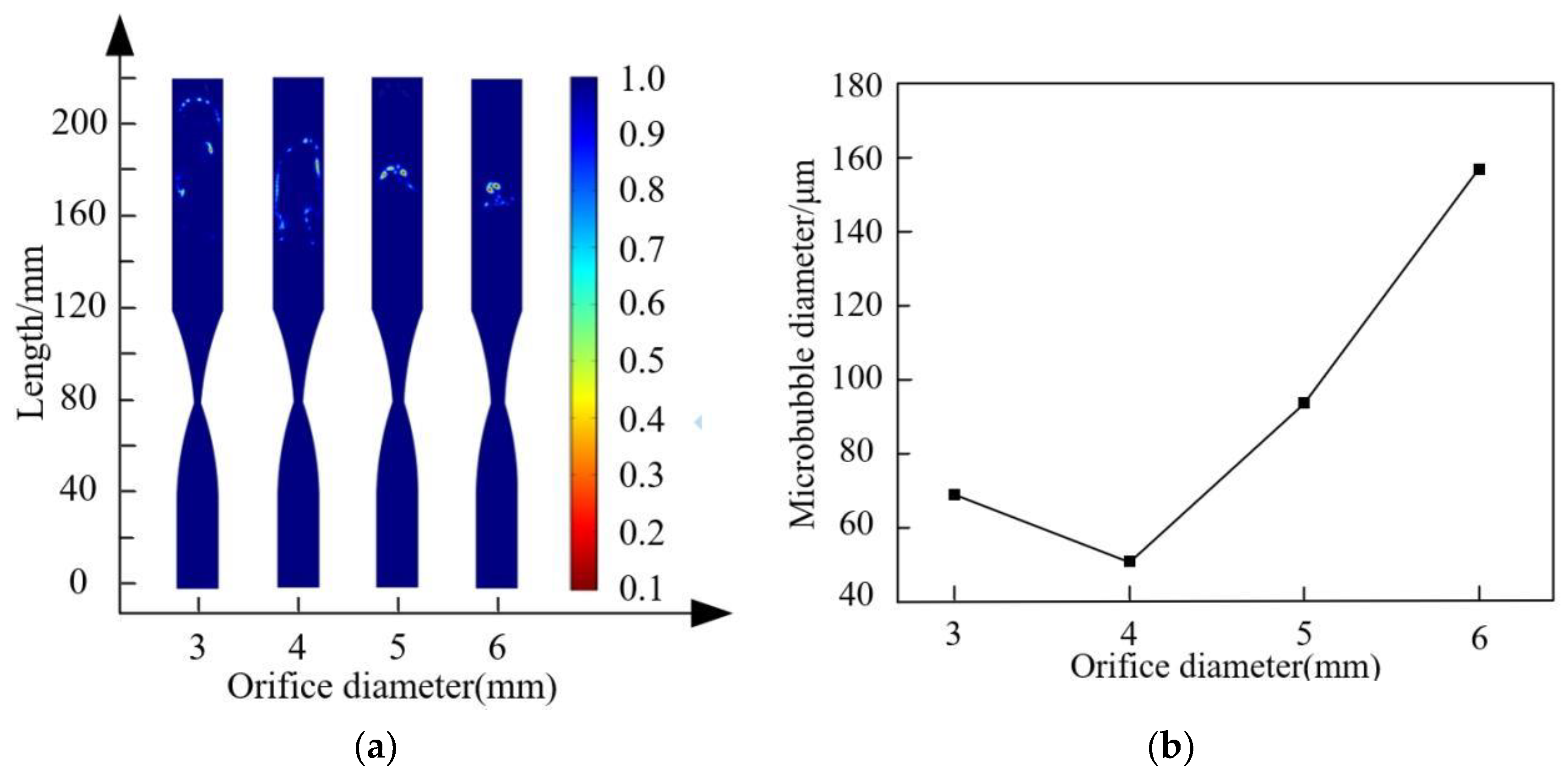
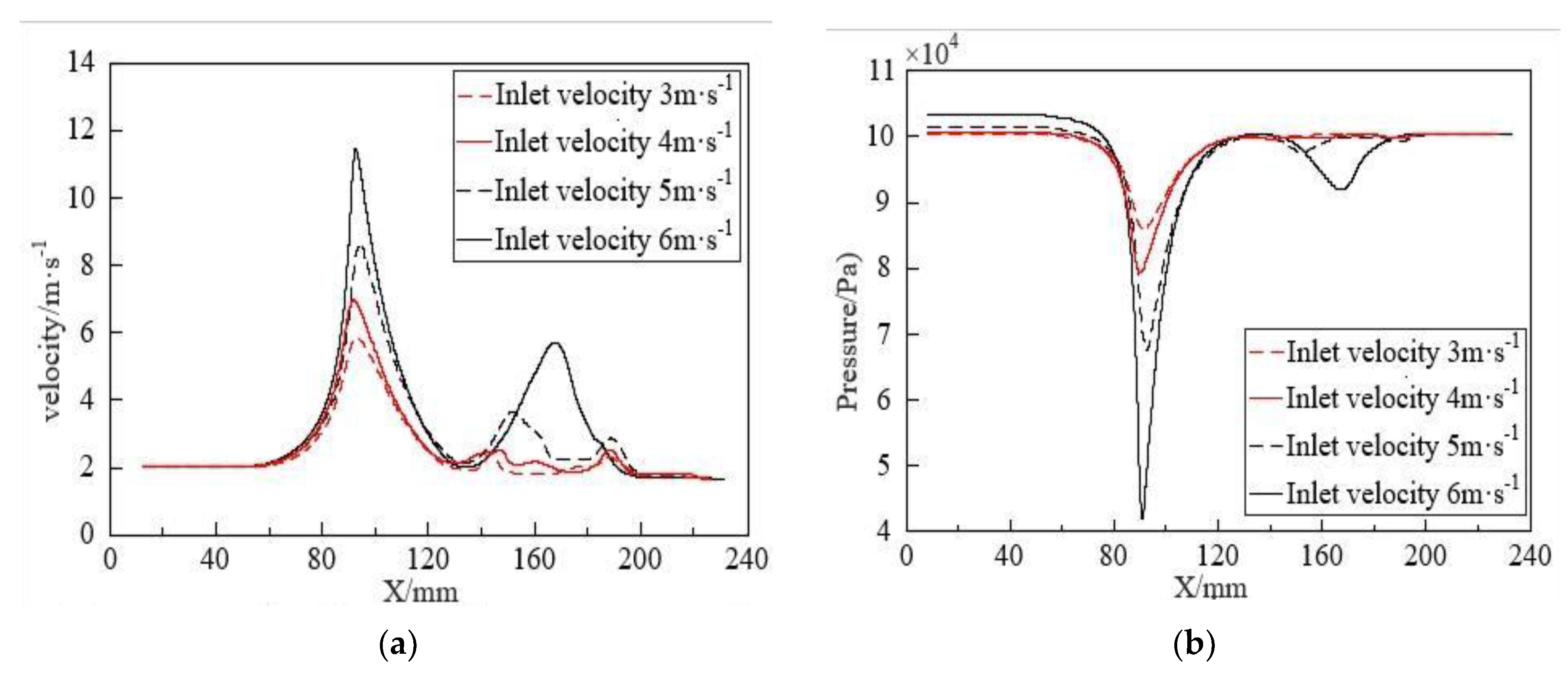
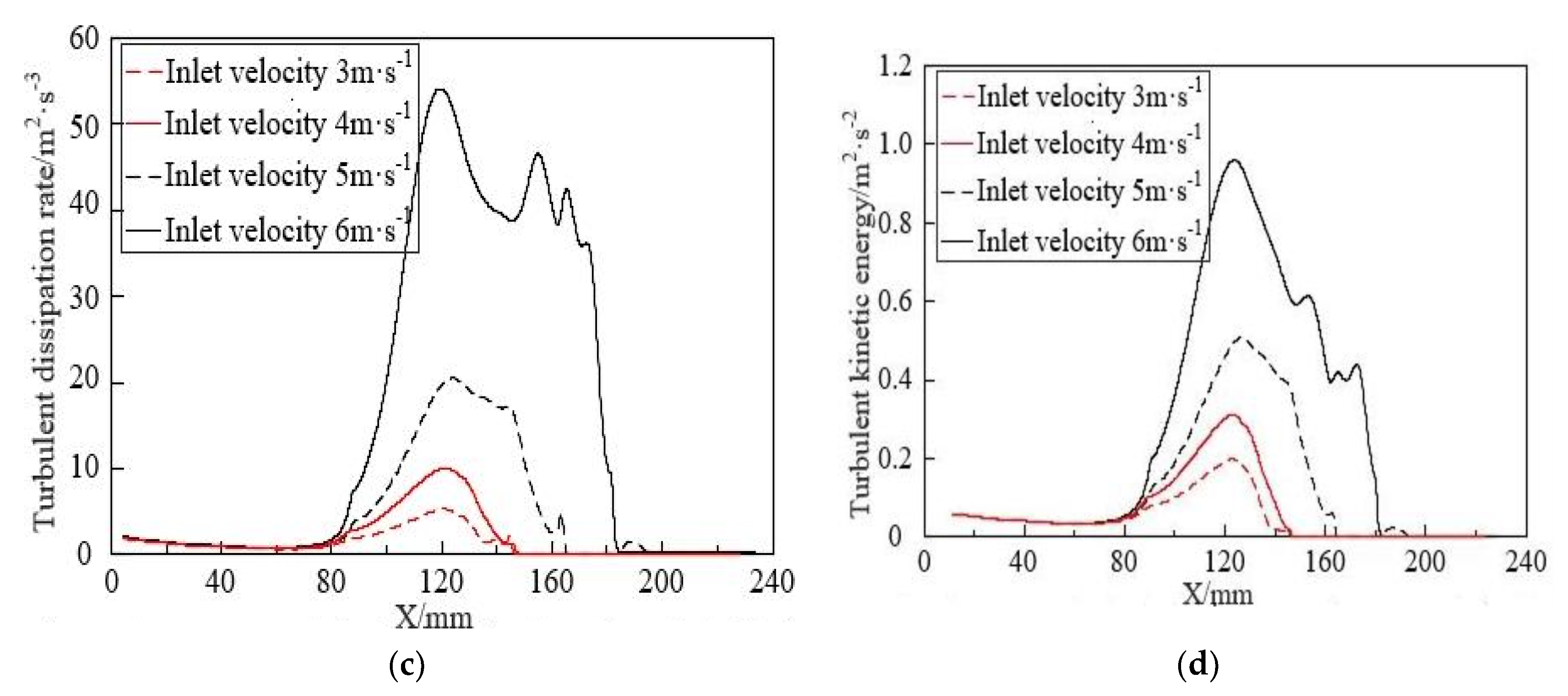
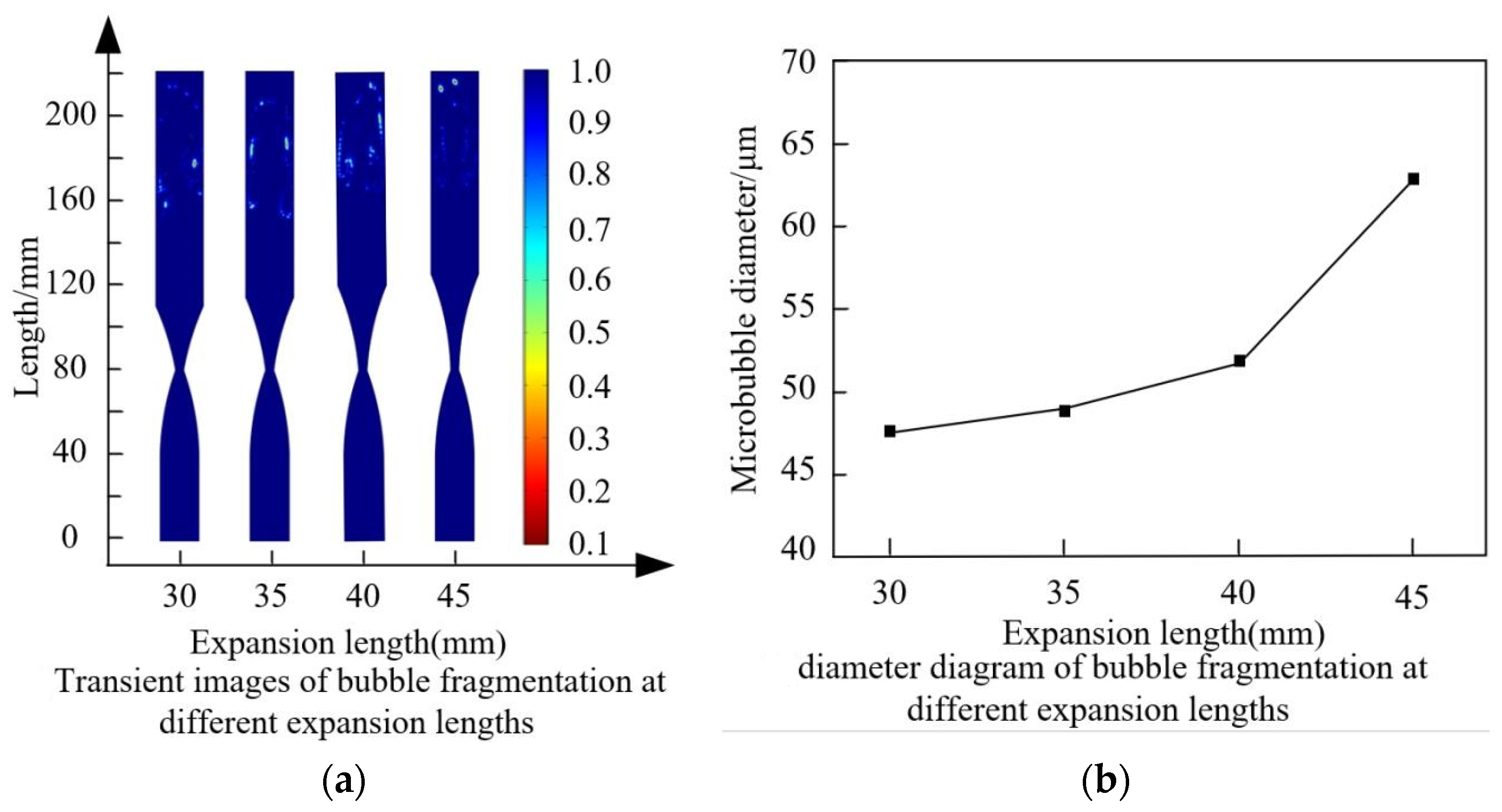
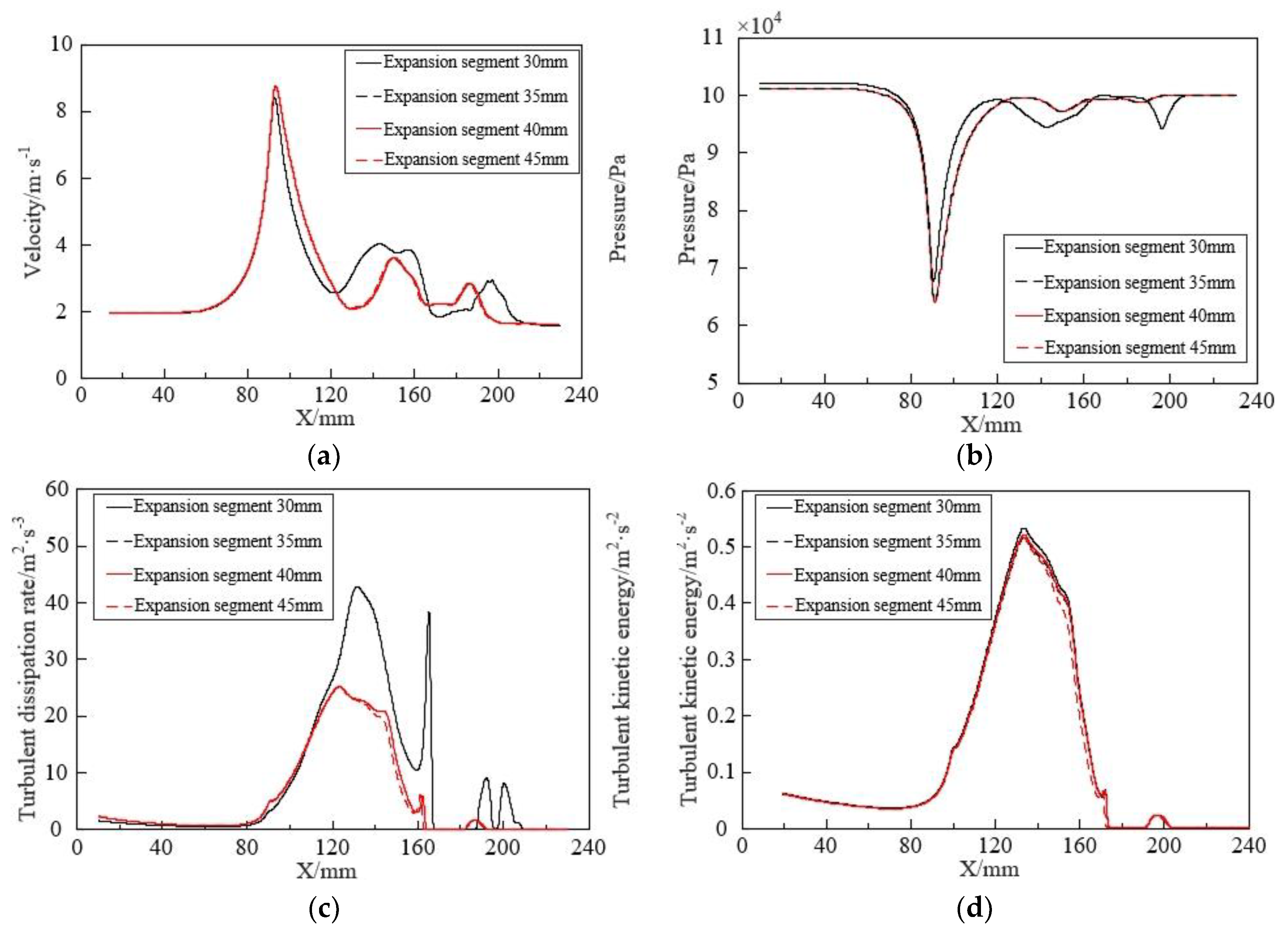

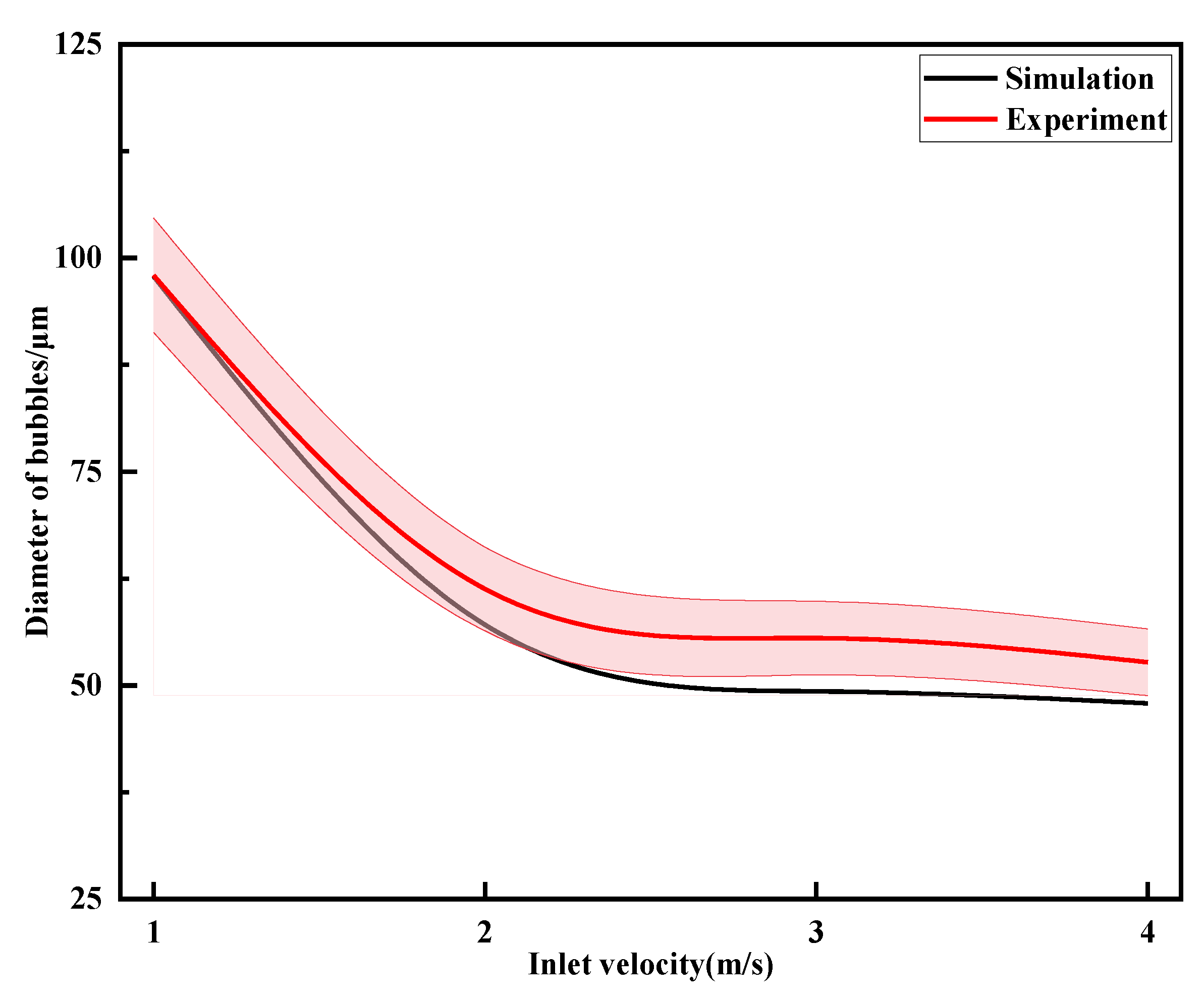
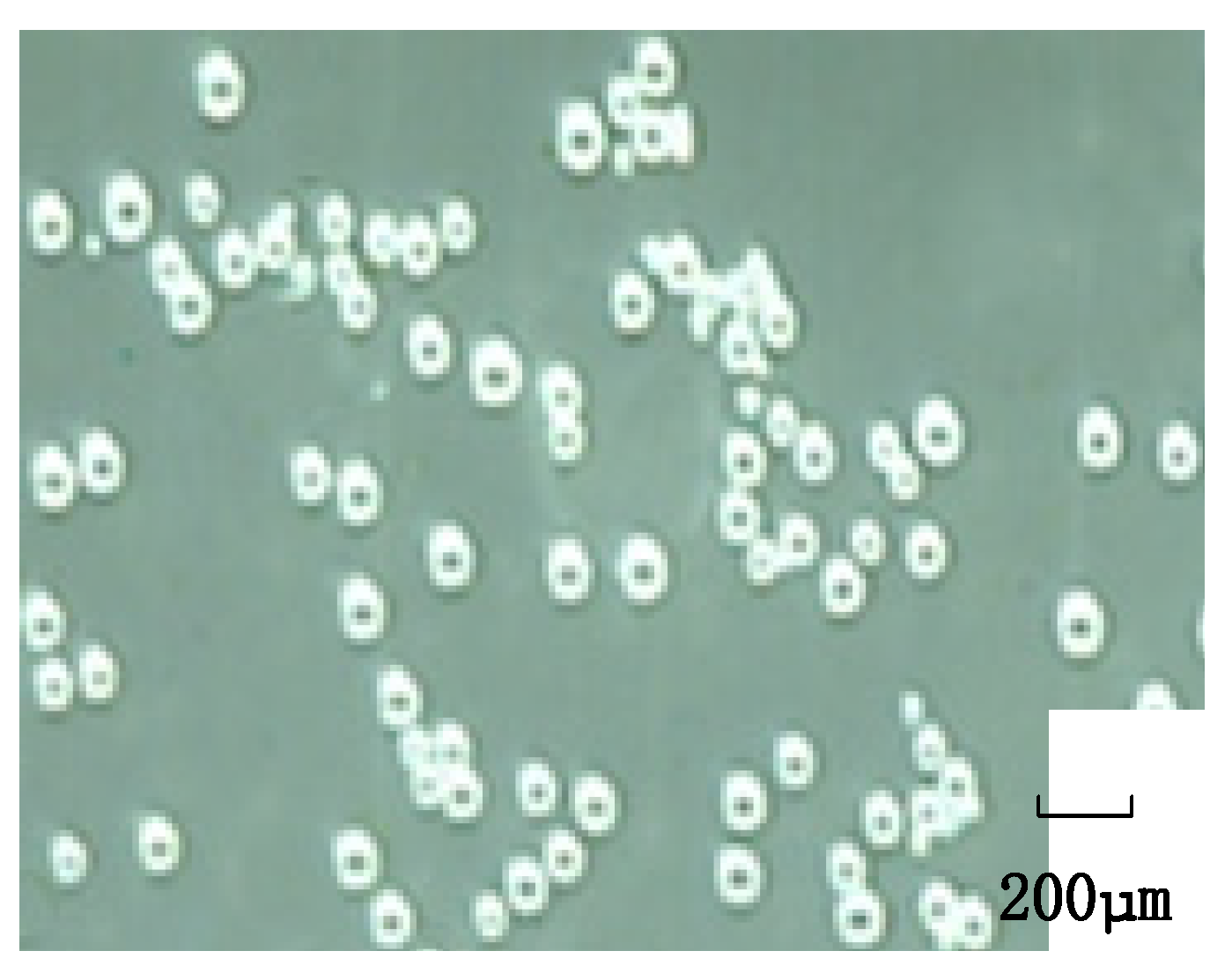

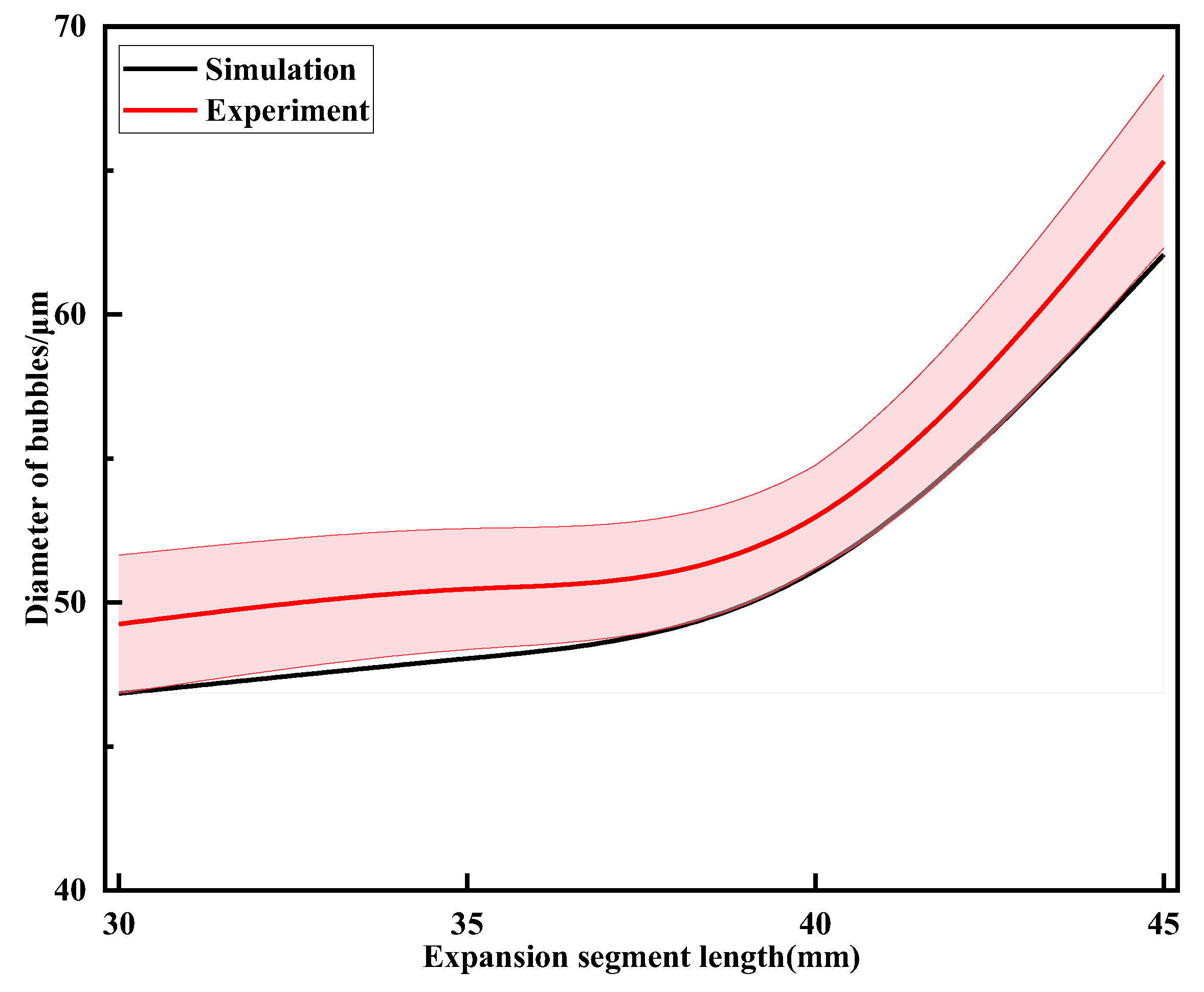
| Number | Grid Number | Average Turbulent Flow Dissipation Rate/ | Relative Deviation/% |
|---|---|---|---|
| 1 | 85,427 | 110.98 | - |
| 2 | 114,362 | 105.73 | 4.73 |
| 3 | 206,523 | 104.85 | 0.83 |
| 4 | 334,562 | 104.45 | 0.38 |
| Model | Pressure Drop across the Inlet and Outlet/kPa | Error Value/% | |
|---|---|---|---|
| Simulated Value | Experimental Value | ||
| Standard | 8.84 | 10.53 | 16.05 |
| RNG | 10.41 | 10.53 | 1.15 |
| Reynolds stress | 13.10 | 10.53 | 24.41 |
| Throttling Orifice Diameter r (mm) | Expansion Section Length D (mm) | Inlet Velocity v (m·s−1) |
|---|---|---|
| 3 | 30 | 1 |
| 4 | 35 | 2 |
| 5 | 40 | 3 |
| 6 | 45 | 4 |
Disclaimer/Publisher’s Note: The statements, opinions and data contained in all publications are solely those of the individual author(s) and contributor(s) and not of MDPI and/or the editor(s). MDPI and/or the editor(s) disclaim responsibility for any injury to people or property resulting from any ideas, methods, instructions or products referred to in the content. |
© 2024 by the authors. Licensee MDPI, Basel, Switzerland. This article is an open access article distributed under the terms and conditions of the Creative Commons Attribution (CC BY) license (https://creativecommons.org/licenses/by/4.0/).
Share and Cite
Zhang, Y.; Huang, Z.; Sun, L. Fragmentation Characteristics of Bubbles in a Throttling Hole Pipe. Micromachines 2024, 15, 1025. https://doi.org/10.3390/mi15081025
Zhang Y, Huang Z, Sun L. Fragmentation Characteristics of Bubbles in a Throttling Hole Pipe. Micromachines. 2024; 15(8):1025. https://doi.org/10.3390/mi15081025
Chicago/Turabian StyleZhang, Yufeng, Zhijie Huang, and Lixia Sun. 2024. "Fragmentation Characteristics of Bubbles in a Throttling Hole Pipe" Micromachines 15, no. 8: 1025. https://doi.org/10.3390/mi15081025
APA StyleZhang, Y., Huang, Z., & Sun, L. (2024). Fragmentation Characteristics of Bubbles in a Throttling Hole Pipe. Micromachines, 15(8), 1025. https://doi.org/10.3390/mi15081025





